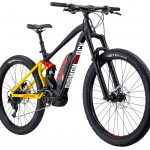Ending of an Era

Late on Tuesday the 12th of October I rode back from work for the last time, so my electrically assisted commuting to work and back days have finally come to an end.

It nearly did not happen as I needed to replace the tyre on the back as it was time to change the tubeless sealant and the tyre was worn out. But it got done in the morning, and I had a great ride to work cross country of 14 miles on my new back tyre and a 10 mile ride home.

My last set of working days were late shifts, with a potential six in a row, but that did not happen. My first day of work on Friday the 8th of October was spent on call at home. Saturday I worked and enjoyed a 12 mile cross country ride to work and usual 10 mile ride home. This was bedding in a newly installed transmission, the whole lot changed with new Chain, Chain ring, Cassette, and jockey wheels and the very oily rear mech removed and de greased. It felt very nice. The old cassette had lasted 1,868 miles with the help of a new chain and 12 tooth top gear cog swapped over at 700 miles when the chain reached its wear limit.

Sunday the 10th of October was a paid day of work but I was rostered to study some of my required knowledge to do my job and with two days to go I did not need to do this so it was really a day off.

Monday was quite an early start for a late shift job and entailed riding away from my house at 10:30 in the morning. A 14 mile cross country ride in lovely weather and normal 10 mile ride home. I should have taken my hurried pictures on that day but did it instead on my last day.

The last day on Tuesday was a late starting shift and I rode away from my house at 3:00PM.
I have been suffering for sometime with tennis elbow in my right arm. I guess in my case this has been caused by a combination of my age meaning I have lost some of the strength and muscle definition in my arms combined with some repetitive strain in my right hand and riding my bike cross country.
Anyway, probably because it is called tennis elbow I had not taken it as seriously as I should. Anyway after that last ride I am now seriously effected, struggled through my last day and have started doing the exercises I found online that are supposed to help.
It had been grumbling for some time but ignoring it was a bit stupid. What seemed to make it a lot worse was those occasions on my ride when I needed to lift the front wheel over small fallen tree trunks/thicker branches across the tracks I ride.
There are four of these where if you approach with the right speed/momentum, not too fast but not too slow, pull up the front wheel to land it either just the other side of the obstacle or on the downward slope of it, using a combination of pedal pressure and weight distribution and speed to then shift your weight forward as your front wheel lands on either the other side or the downward slope of the obstacle to allow the rear wheel to follow.
Anyway getting the front wheel off the ground can be done with very little effort if you use the correct technique but equally can put some strain on your arms if not done badly. And it was one of these done badly that really effected my tennis elbow.
On an off road motorbike you can apply the front brake to dip the front forks just before the obstacle to lift the front wheel as the front fork un weights by again shifting your weight distribution and application of the right amount of power.
The ride was great but the injury at a whole new level!
So I have started retirement with a crippled right elbow and right hand. Great.
Those three rides added another 70 miles to my total.
So after starting to use The Yamaha Haibike in March 2015 to ride to work, cross country there and on the road home I have ended up with a total mileage of 14,312. Apart from worn out parts (Lots) I have used the bike as I bought her for £1750 in March 2015, but was lucky to get a new motor under warranty and be able repair the battery leads when they broke.
I have been genuinely impressed by it as parts of my off road route to work are properly rough and demanding single track as well as the more mundane tracks, so it has had to cope with a lot of punishment.
I will find some use for her I am sure in retirement. Having just changed the transmission I will probably use her just as she is, but for the more challenging off road tracks I have available to me in my area will probably need to lower the gearing.
The cheapest way would be to change my 42 tooth chain ring for a 38 tooth one and swap the two top gear cogs on my rear cassette that are currently 14 and 12 tooth cogs for 13 and 11 tooth ones, to retain some ability to travel faster on the road when required.













